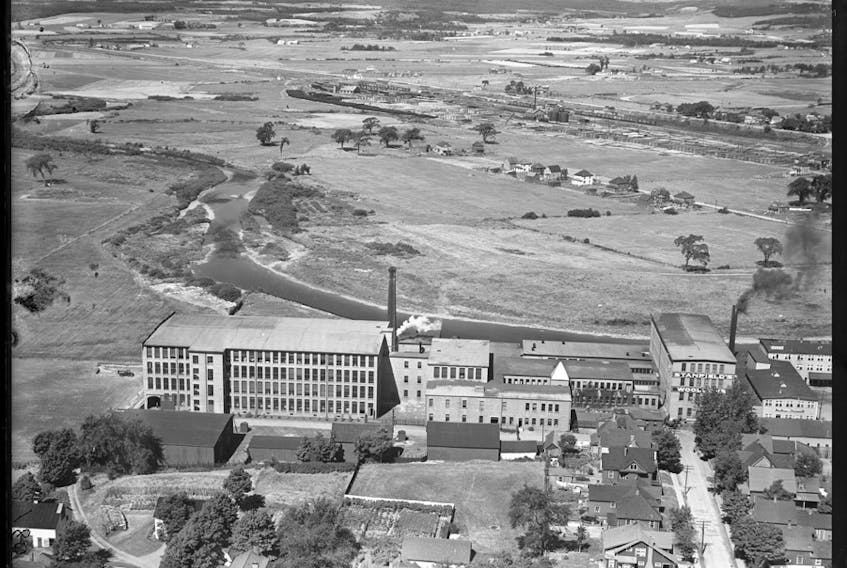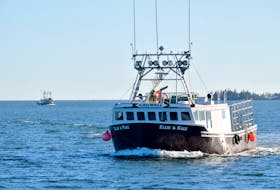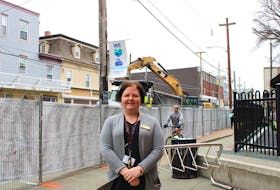After issuing layoff notices and closing down Stanfield’s manufacturing plant on March 16, Jon Stanfield sat alone in his office and pondered both the past and the future.
“The future looked very scary for this type of company,” Stanfield’s president and CEO told reporters during a virtual media conference earlier this week.
“I was just envisioning when I was sitting here by myself, after laying all the people off, of back in the 19-teens, I think that’s what you would call it, when this factory would have just been full of sheep wool flying everywhere making wool blankets for those Canadian soldiers in those terrible front lines where they had to battle. And, when I sat here, I had the same inner-gut feeling, that we had to do something. That we had to make sure that we supported this cause … .”
Stanfield thought about the COVID-19 crisis blanketing the country and wondered how he could help. What could he, as the fifth-generation leader of his family’s firm, do to extend the centuries-old legacy that he was born into and which was now his responsibility to carry on?
This week, while sitting in the factory's aged, wood-adorned boardroom – with framed pictures of his forefathers hung on the wall behind him – in the same brick factory that has been producing underwear, war-time necessities and other garments since 1882, Stanfield laid out the results of the fast-paced plans that have come to fruition.
“We stand here today making the gowns in the same factory that opened in that timeframe,” Stanfield said. “I’m tremendously excited that I can carry the legacy on of what our former leaders did through all of the years to stand up this company - you know, we’re still family-owned, we’re five generations, we’re 164 years old, with deep roots - to what it means to be Canadian.”
“There’s an extreme level of pride in Truro today. I am an excited fifth generation Stanfield family leader of this venerable company, following in all my forefather’s footsteps, including my father (Tom), who is staying at home during this time, and supporting Canada during this crisis.” - Jon Stanfield
In the midst of his solitary pondering, Stanfield reached out to some local ER doctors, including Dr. Stephen Ellis, for some advice on the possibility of producing medical gowns and/or face masks. His thought process, he said, was “what can we do to help the cause and what can we do the fastest?”
He arranged to have Ellis drop off one of the medical gowns in his mailbox to use as a spec for a prototype and over the coming days proceeded to connect with provincial and federal officials with his concept.
Those efforts culminated in this week’s announcement that Stanfield’s would be proceeding with a $24-million federal contract to produce 2.6 million gowns between early May and late October and a provincial contract valued at $4.32 million to supply 480,000 gowns over 16 weeks. The contract with the Nova Scotia government and the Nova Scotia Health Authority includes an option, if required, to provide an additional 240,000 gowns over eight more weeks.
“I think it’s a legacy thing of our brand. We have always been dedicated to this country and to Canada through what I can read of all of my forefathers,” Stanfield said, during the video conference.
But in addition to providing a fast-paced influx of drastically needed protective medical gowns, the Stanfield-inspired initiative also translates into a call-back of 72 laid-off employees and a call-out for at least 108 immediate new hires. That’s 180 motivated people who can proudly go to work knowing that not only are they earning a livelihood but, that they too, are contributing to the national cause.
“There’s a big new hire that is going to happen in Truro,” Stanfield said. “We had overwhelming support on the weekend, like 500 applicants came in to support our efforts.”
That sentiment carries over to a number of other companies that will be helping to fulfill the quota the Stanfield’s contracts mandate.
“This is not just making branded products, this is supporting the health crisis we have in Canada and people are really stepping up and saying they want to be part of that and support these efforts,” he said, of officials from companies in New Brunswick, Quebec and numerous others in Ontario whose futures and employees also stand to benefit from the gown contracts.
From the perspective of his company alone, Stanfield described the impact of the contracts as “immense.”
“The future looked very scary for this type of company. So we quickly pivoted to really determine what we could do to support it and these two contracts will provide a very nice bridge to allow us to get through the crisis to see where the economy lies at the end of it and how consumers and our retail channel partners are reacting as they open their businesses, rebuild the consumer traffic that’s required for people to buy our brand. But it will be a significant impact over the next six to eight months on our business,” he said.
“I think this is a great symbol of not letting manufacturing go and having manufacturers who can support these types of things when needed. I think over the years manufacturing has been a little bit maligned in the country.”
The material for the gowns is being produced by Intertape Polymer in Truro and Stanfield said it is important to consider such made-at-home manufacturing capabilities for well beyond the point when the COVID pandemic ends.
“… we need to ensure that we have the capacity domestically to support these types of things,” he said. “We have such great innovation and great ingenuity in Canada, we have to make sure in the future, as a result of what’s happened here, that we have a level of domestic supply and readiness right across the country. And really, that can’t be turned off after this. There needs to be a mid-term solution to this and a long-term solution to this.”
While that need not entail Canadian companies producing gowns, masks or ventilators on the scale they are required now, manufacturers should be equipped so they can maintain available output and allow it to ramp up faster.
“So, if we have to turn the dial up again and switch up a bit you can,” Stanfield said. “Because when borders start to close and supply chains go to zero, it’s very difficult for a country of our size, meaning 37 million versus the behemoth south of us of, 390 million, and European nations, these people gobble up supplies very quickly. So, we have to be sure that we have two lines of supplies.”
In expressing his pride at being able to contriubte to the coronavirus battle, Stanfield said he was also grateful that other suppliers were so willing and ready to jump on board.
“I’m just thankful that we have the ability to do this and I’m grateful that we have great other suppliers who have just put up their hand and said: 'Jon we’re in with you and we can go at this really quickly', which I think is just fantastic.”
Learn more about Stanfield’s Ltd.
Founded in 1856 in Tryon, P.E.I., as Tyron Woolen Mills by Charles E. Stanfield and his brother-in-law Samuel E. Dawson;
A decade later, Stanfield sold his company interests to Dawson and moved to Truro, N.S.;
In 1870, Stanfield established Truro Woolen Mills on Brunswick Street;
The textile mill that stands today on Logan Street was opened in 1882.
The company, which has become famous for its underwear, created heavy, shrink-proof woolen underwear during the Klondike gold rush of the 1890s, as well as providing woolen blankets for First World War Canadian soldiers, base layers of clothing during the Second World War and winter base layers (shirts, bottoms and boxer briefs) during the war in Afghanistan.









